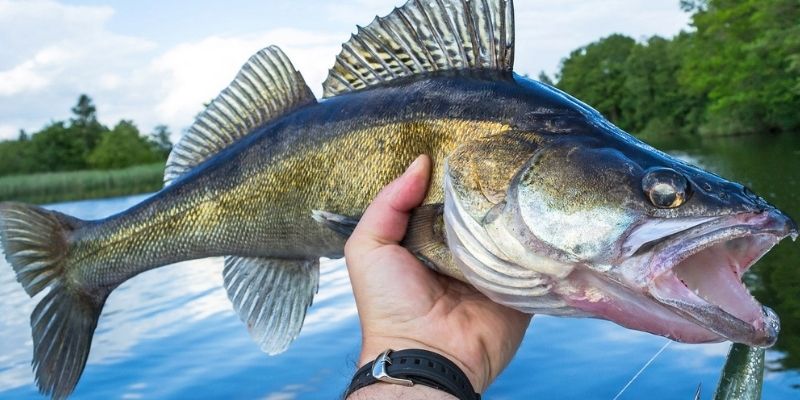Walleye are freshwater fish that live in rivers, natural lakes, and reservoirs. They prefer cooler water temperatures found in both clear and turbid, shallow or deep water. Walleye reproduce at about 3 to 4 years of age. What are Ideal Water Conditions for Walleye?
Walleye live in rivers, natural lakes, and reservoirs, in the US, in both clear & turbid, as well as both shallow & deep water.
- Temperature: 50-70°F
- Clearwater
- Adequate oxygen levels
- Presence of structural elements
- Moderate water currents
- Wind-induced surface chop
- Stable weather conditions
- Variable depths
Anglers often fish for walleye when it is windy because the wind stirs up the bottom of a lake and makes the water turbid. Walleye are great hunters of food in murky water because of their good eyesight, so anglers are often successful when the wind blows. Anglers call good fishing in the wind the walleye chop.
Introduction:
Walleye (Sander vitreus) are a freshwater fish species native to North America, prized by anglers for their tasty flesh and challenging behavior. They are named for their distinctive pearlescent eyes, which possess a reflective layer that enhances their vision in low-light conditions. Walleye typically inhabit cool, clear lakes and rivers, although they can adapt to a variety of aquatic environments. They are known for their predatory nature, often preying on smaller fish and aquatic insects.
Understanding water conditions is paramount for successful Walleye fishing due to their highly specific habitat preferences and feeding behavior. Various factors such as water temperature, clarity, oxygen levels, structural elements, currents, and weather conditions all influence Walleye activity and distribution. Anglers who can identify and adapt to these conditions are more likely to locate productive fishing spots and increase their chances of catching Walleye. Additionally, a deeper understanding of water conditions allows anglers to employ effective fishing techniques and strategies tailored to the prevailing environmental factors, enhancing their overall fishing experience and success rate.
Ideal Temperature Range for Walleye
Ideal Temperature Range for Walleye Habitat:
References:
MarCum Technologies- WALLEYE WARM WATER TEMPERATURE TRANSITIONS
FAQ’s
The best baits for catching Walleye include minnows, nightcrawlers, leeches, and artificial lures such as jigs, crankbaits, and soft plastics. Experimenting with different baits and presentations can help determine what Walleye are actively feeding on in a particular water body and under current conditions.
- How do I locate Walleye in a new lake or river?
To handle and release Walleye properly for their survival, follow these steps:
- Handle them gently using wet hands or a rubberized landing net to minimize stress and protect their delicate slime coat.
- Use barbless hooks or crimp-down barbs to facilitate easy hook removal and reduce injury to the fish.
- Avoid placing Walleye on dry surfaces or rough surfaces that can damage their skin and scales.
- Hold Walleye horizontally, supporting their body properly, especially larger specimens, to prevent spine damage.
- Minimize air exposure by keeping them in the water as much as possible, only lifting them briefly for quick photos.
- Release Walleye in calm, oxygen-rich waters, away from predators and heavy fishing pressure, allowing them to swim away strongly.
- Consider using a fish release tool or descending device for fish that exhibit signs of barotrauma, such as a bloated swim bladder, before releasing them back into deeper water. By following these guidelines, anglers can help ensure the survival of released Walleye



